Recently in investment Category
By Krys Cail
Over the past decade or so, social trends have emerged that promote local economic exchange around a regional or local food system. The rise in popularity of farmers’ markets is shown by the 16 percent increase in number of markets between 2009 and 2010.[1] Grocery stores, college cafeterias, and now even Walmart stores are trying to source more fruits and vegetables from local growers.
Slow Food is an international NGO that began in Italy but is now world-wide in scope. It celebrates the local and regional culture of the table while encouraging taking the time to enjoy basic social activities, like sharing food. Indirectly, the Slow Food movement also encourages local culinary, agricultural, and wine tourism industries. In the Tompkins County area, we have made significant progress in the development of local and regional food systems, often in collaboration with the region’s grape growers and wine makers. Local food is a current focus of local interest that we would be well served to further develop in view of energy decline and the need to shorten food supply chains.
The Slow Food Movement was among the inspirations for the work of Woody Tasch, a socially responsible investing leader and author. He coined the term “Slow Money” to describe investing in the local foodshed with a portion of one’s portfolio—with an understanding that this investment might pay off better in social and environmental benefits while generating a somewhat lower financial return. His book, Inquiries into Slow Money: Investing As If Food, Farms and Fertility Mattered[2], inspired others, and a number of like-minded individuals launched an effort aimed at starting a Slow Money Movement[3]. They adopted a goal—one million people investing one percent of their assets in local food systems within ten years. They also adopted principles[4] and began working with local and regional Slow Money organizations to establish investment programs. Slow Money has gained some national recognition over the past couple of years, with articles appearing in Business Week[5] (one of their “big ideas for 2010”), Entrepreneur.com [6] (one of “five financing trends for 2011”), Utne Reader[7], Time[8], The Wall St. Journal[9], and The Los Angeles Times[10].
A local group, loosely affiliated with the national movement, has begun planning activities here in Tompkins County. This Slow Money Central New York group can be contacted through the Alternatives Business CENTS program[11] or Local First Ithaca[12].
Envisioning a new investment paradigm is difficult theoretical work, but actually implementing a system that directs flows of investment cash into local food systems is even more difficult. As a nascent movement, Slow Money has moved methodically to build a robust infrastructure for implementation. A growing national network of interested people have been considering how local groups or “Slow Money Alliances” would be structured in order to accomplish the work of bringing more investment into local food systems. The national Slow Money Alliance uses a number of other national organizations as models, including Slow Food, BALLE (Business Alliance for Local Living Economies), Social Ventures Partners, and Transition US. There is a focus on preparing for energy descent through relocalization by investing in local food systems.
Investors may have a simple need—to keep at least a portion of their portfolio invested in the local foodshed. Food buyers, both in the urban areas in the region and in the Tompkins County area, also want to buy food from nearby. This gets complicated very quickly, however, by rural/urban interdependence. Cities, and especially huge port cities like NYC, relocalize by becoming more dependent on a regional, not local, foodshed. Rural areas in the region may be dependent on investment from the urban areas. Tompkins County may or may not be in a position in the future to source investment capital from local investors alone; rural areas may find that they continue to have some dependence on larger regional centers of finance. Many Tompkins County farm and food businesses currently sell a portion of their produce to local markets, and also ship a portion to regional urban population centers, most typically NYC. Tompkins County is within the NYC Greenmarkets catchment area, and currently, many local food producers make the trip to sell in those lucrative markets. While that pattern may change some as the price of truck transportation increases markedly, it may not: sourcing fresh foods from even farther away may cost yet more, making the relative cost of Tompkins County grown food in NYC still attractive.
Additionally, wholesale foodstuff supply chains move food from local farms and food processors into urban markets. Locally-owned shipping companies, such as Regional Access[13], may adapt to new transportation approaches as fossil fuels increase in price. For example, multi-modal shipping via train and/or barge would allow shelf-stable or cooled produce to travel more economically. One gallon of fuel will take a ton of freight about 155 miles by truck, 413 miles by train, and 576 miles by barge.[14] In particular, crops such as grains, beans, seeds, oils, and meats that require a large land base for their production are likely to continue to be imported into large cities from their peripheral rural areas. In many cases, it’s more cost-effective to manufacture minimally processed foods, such as canned or dried fruits and vegetables, closer to where they are grown, and then ship them via lower-energy transport, such as barges or trains. Tompkins County is exceptionally well placed to ship local goods by water; it is possible to send goods by boat from Ithaca to anywhere on the Great Lakes, the Mississippi, or the East Coast.
The Central NY Slow Money Group has been meeting at the Alternatives Federal Credit Union[15]. The group has established a cooperative, interdependent relationship with Slow Money NYC. Central NY generally, and Tompkins County in particular, has many farm and food enterprises, but relatively fewer eager high-net-worth investors. For NYC, that situation is reversed. Some collaboration can be of value, allowing people who eat Tompkins County food to invest in Tompkins County food growers and processors, whether they live very near the farm or in the nearest megalopolis.
Access to capital can be gained by a business through an equity deal (selling portions or shares of business ownership) or through debt instruments (loans requiring a stipulated repayment schedule, but conferring no ownership rights). There are also hybrid arrangements, such as debt instruments that convert to equity shares if not repaid over a certain period. Under the current regulatory framework, it is difficult—not impossible, just difficult—to raise private equity funds for a business venture from a large number of investors of limited means. Typically, “qualified investors” (those with more than one million dollars in net worth) are able to play by somewhat different rules than the rest of us, as the regulators consider them to be savvy enough to fend for themselves in the investment world. To make an offering to a group of people who are not all “qualified investors” (for instance, the membership of Greenstar Cooperative Market), some form of an intermediary fund is probably most practical.
Cooperative membership/ownership organizations are but one model that allows for a large group of investors to provide capital and share risk. The CSA (Community Supported Agriculture) model is another approach. Slow Money groups at the national, local, and NYC levels are all exploring the best ways to facilitate these kinds of transactions, meeting the needs of businesses while mitigating exposure to risk for investors and also keeping some liquidity for investors.
Slow Money group members seek to meet two very different kinds of needs with one suite of mechanisms.
First, investors want to move beyond socially-responsible investment opportunities and now want to invest their money in businesses that have a triple-bottom-line benefit: businesses that are socially responsible and environmentally appropriate while also making some profit. People who understand the inevitability of energy decline may well want their money invested in shortening the supply chains for essentials like foodstuffs.
Second, small farm and food businesses need access to capital to grow and process the foodstuff supplies that we need in a more localized or regionalized food system. Traditional financing, still stuck in a global market worldview, is often disinclined to channel investment into the type of enterprise that could help smooth the adjustment to a world with a lot less oil.
Three opportunities for investment in Tompkins County food systems
Several local initiatives offer both Tompkins County residents and city dwellers the opportunity to invest “slow money” here. In the following, I’ll briefly describe three of them.
Local opportunity number 1: Facilitating land acquisition by prospective farmers trained at Groundswell
Groundswell[16] is a program that uses both classroom teaching and on-farm training to teach students to farm. If there is one practical suggestion for an easier transition in the face of energy decline, it is that more people need to learn to be able to grow food. In a globalized market for energy, food-growing resources have been diverted to the production of fuels such as ethanol, which, in combination with increases in costs of petrochemical inputs into industrial farming, has caused food commodities to experience great price volatility. In the near term, we are likely to see spot price run-ups and shortages, while in the long run, food grown closer to home and with more animal-power, human attention and labor, and organic inputs will be more sustainable. Groundswell’s programs are tailored to producing more farmers through a classroom-based curriculum of instruction delivered at EcoVillage at Ithaca, dovetailed with hands-on farming apprenticeship in a structured program that exposes students to many local farms. The emphasis on sustainable and organic methods prepares new farmers to farm with less reliance on fossil fuels. When newly-trained would-be farmers emerge from this training, however, they require land to farm.
Some communities, such as Burlington, Vermont, have established agricultural land specifically set aside for use by beginning farmers. The Intervale in Burlington is an area that includes community gardens as well as small acreages for use by tenant farmers who are just starting out in vegetable farming. The land has excellent soil and is close to housing in the city. The location is ideally suited for this purpose, and the property has been protected from development by the generous action of a philanthropist. Tompkins County currently lacks such tenant-farming options, but Groundswell is attempting to develop similar options locally.
Joanna Greene, Executive Director of Groundswell, has worked with local farmers and EcoVillage to establish a farm incubator program in Tompkins County. If an intermediary financial capital stream were available, the graduates of such programs would be ideally suited to match with a group of local investors. Alternatively, CSA models or direct equity investment on the part of larger, qualified investors, or debt-to-equity financing, may be more appropriate financing approaches. A “Slow Money” program could take a number of forms. Joanna has been participating in Slow Money planning talks, representing the needs of beginning farmers.
Local opportunity number 2: Facilitating grain processing for local grain farmers through Farmer Ground Flour
Grain farmers Erick Smith and Thor Oeschner joined forces with Greg Mol about a year ago to begin a grain-milling operation in Trumansburg, Farmer Ground Flour[17]. They use a modern mill that can make up to 15,000 pounds of flour a month. They began by grinding the wheat, spelt, corn, rye, and other grains they grew. At first, they had to take the grain to Penn Yan to dehusk it, but now that operation is handled at one of the farms.
They clearly hit an area of the food system ready for development. By January 2011 they were in the New York Times in an article titled “Reviving New York State’s Grain Belt”[18]. To quote from the article:
It is a cooperative effort among several farms growing organic corn, spelt and wheat, often heirloom varieties…. Packaged under the Farmer Ground Flour label, the flours are sold in paper sacks in Greenmarkets by Cayuga Pure Organics, a participant in the cooperative. The flours are fresh, and have not sat for months in warehouses.
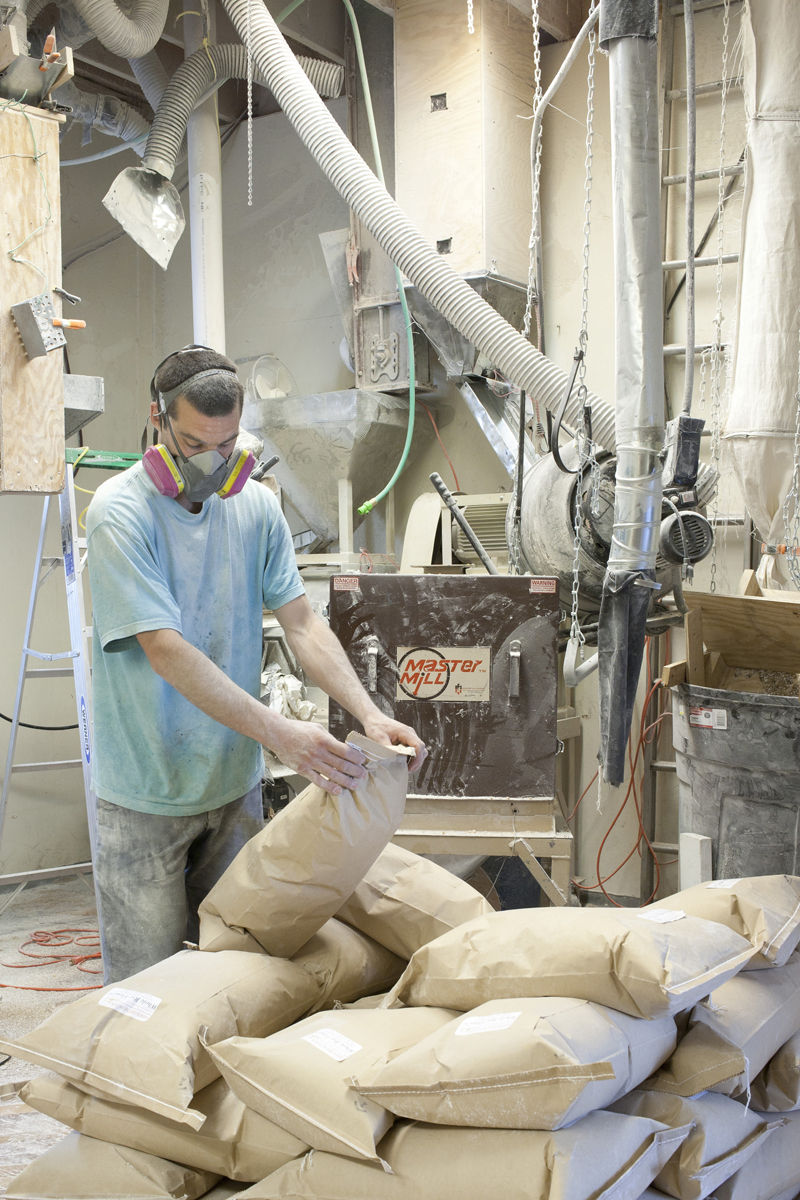
Greg Mol bags rye flour at Farmer Ground Flour
Located at the old Agway building in Trumansburg, the mill occupies a site where animal feed was milled in the past. In many ways, it is an ideal site for an enterprise that includes a lot of unloading grain from trucks and a lot of loading flour and other milled products back onto them.
Farmer Ground Flour has been very successful in meeting an emerging need for artisan-milled flours and meals in NYC. That is not, however, their only emphasis. They also sell flour and other milled products to the local market, through Regional Access, Greenstar Coop Natural Foods Market, and Garden Gate home delivery service. A recent edition of GreenLeaf[19], the newsletter of Greenstar Coop Natural Foods Market, showed the big-picture development of Farmer Ground Flour in historical perspective:
Farmer Ground’s success is part of a larger effort to restore grain growing to New York state. While now thought of as dairy country, upstate New York once grew so much grain that Rochester topped the nation’s flour production in the mid 1830s, giving it the nickname “Flour City.” (A later rise of nursery businesses changed that moniker to “Flower City.”) That flour was shipped to New York City and beyond via the Erie Canal.
Oechsner and Smith have both worked closely with Elizabeth Dyck, of the Organic Research and Information Sharing Network, which seeks to reintroduce wheat growing to New York state… [She] is working with farmers like Oechsner to identify those [varieties] that grow well in New York’s challenging climate, and, just as importantly, also taste great and bake well.
…Like other foods, “the flavor has been bred out of wheat,” [Oeschner] explained, in favor of yield and uniformity. “Growing the old wheat varieties is like growing an heirloom tomato.”
“Farmer Ground Flour is really making a difference for other farmers,” said Dyck. “They’re a great example of farmers banding together to put needed infrastructure into place, in this case a milling facility. They deserve enormous amounts of respect.”
No question, there is market interest, both regionally and locally, in the product of a local grain mill. But how does a small, “farmer-owned, grown, and ground” operation finance the necessary equipment purchases to keep up with the demand? Greg Mol, Erick Smith, and Thor Oeschner approached banks to seek financing for their equipment needs, but the amount of money that they sought to borrow was too small to fit the lending programs available. They have pursued working with individuals in the community to finance their equipment needs, but there is no organized program for doing so. The need for relatively small infusions of capital hampers their ability to expand and improve Farmer Ground Flour.
Will grain farming for human food expand in New York State only as quickly as the processing capacity is able to expand? Slow Money could be a means by which those interested in the re-development of grain farming in New York State could participate in the effort to develop the needed processing capacity. Greg, Erick, and Thor have already made connections with a few local investors to gain some access to expansion capital, and hope to do more of this in future. And the availability of their product has already spurred other business start-ups and more local investment opportunities. For instance, Wide Awake Bakery[20] operates a bread CSA using Farmer Ground Flour as an input.
Local opportunity number 3: Expanding Cayuga Pure Organics into rolled grains
Erick Smith is not only a partner in Farmer Ground Flour, he is also a principal of Cayuga Pure Organics[21]. Cayuga Pure Organics is the source of much of the “locally grown” beans and grains offered for sale in the Greenmarkets, co-ops, and restaurants of NYC. They also supply our local Tompkins County region with these products. Cayuga Pure Organics was also featured in a New York Times article this year, in the Magazine under “Field Report - Market Watch”[22]. This excerpt shows how Cayuga Pure Organics evolved to serve the niche market it now depends on, growing grains and beans for human consumption, to be sold in Tompkins County and NYC:
In 2003, Erick Smith and Dan Lathwell — men nearing 60 who’d farmed intermittently when not working at Cornell or teaching elsewhere — thought they’d hit upon a smart niche when they created Cayuga Pure Organics to grow pesticide-free feed for the region’s newly organic dairy farms. Two years later, the Ithaca food co-op and a natural-food distributor asked if they’d grow organic beans on their land in the town of Caroline. They were also connected with a local taqueria, and soon the two were struggling to keep up with the restaurant’s weekly order for 500 pounds of black and pinto beans. Then, in the fall of 2008, the farm inspector for New York’s Greenmarket tracked them down in her quest to find a grower to satisfy the demand for local beans and grains.
“We hemmed and hawed, thinking that going to New York City is a whole step up in the organizational process,” said Smith, an articulate man for whom overalls and a graying beard are a natural fit after years of teaching math education. It also required getting up to speed in marketing, which for farmers means both self-promotion and literally selling at markets.
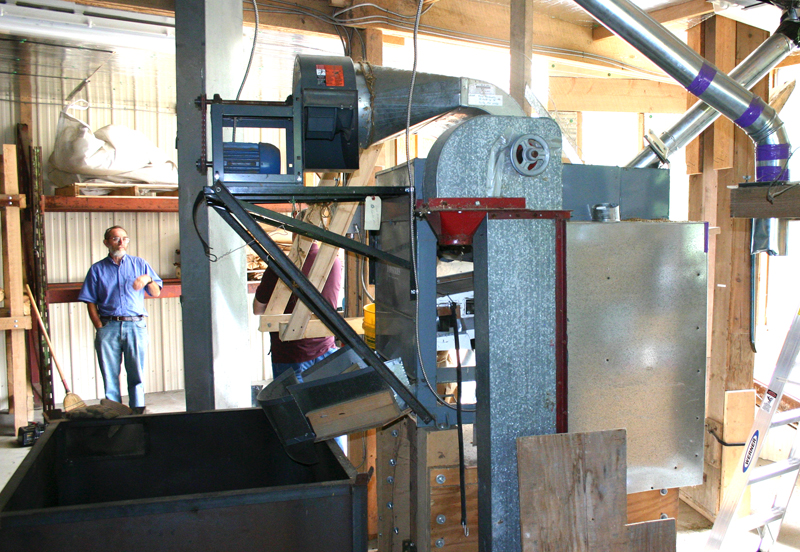
Owner Erick Smith with wheat cleaning equipment at Cayuga Pure Organics
Many of the processes for harvesting, shelling, and cleaning the beans and grains can be handled directly on-farm. Over time, Cayuga Pure Organics has become less dependent on other farmers for the use of processing equipment, streamlining the efficiency of the operation. However, specialized equipment for such tasks can be expensive, and it can be difficult to raise the capital needed to purchase it, house it, and integrate it into the operation. For some time, Cayuga Pure Organics has had plans to purchase equipment to be able to roll oats. Oats are a crop well-suited to our climate in Tompkins County, but they are almost always consumed by humans in the form of rolled oats, also known as oatmeal. Cayuga Pure Organics applied to the NYC Slow Money Group’s first Entrepreneurs Showcase to pitch the idea of investing in this business expansion. They were one of only ten businesses that will be featured in the first Showcase, giving them the opportunity to gain Slow Money investment for this business expansion.
Conclusion
The area between the growing consciousness on the part of consumers that they want to support a more localized food chain on the one hand and farmers who want to grow and provide local foods on the other is ripe with possibility to re-invent investment. While the shape of this emerging movement is not yet clear, the motivations of farmers, food processors, short-haul food transporters, and restaurant chefs are clearly aligned with those of investors with an interest in facilitating a more localized farm and food sector. The roles of regional investors, and the roles of local investors, will be established in part based on who steps forward to help shape the food web through investment and marketing. Perhaps, depending on developments, the Ithaca Hours local currency revival will also play a role. Establishing a farm and food sector in Tompkins County that is able to provide grains, beans, oils, meats, and dairy products to the metropolitan areas of the region as well as the local market seems a relocalizing strategy worthy of the investment of both thought and money.
Postscript from the Farmer: Erick Smith notes some additional benefits and hurdles
Erick Smith of Farmer Ground Flour and Cayuga Pure Organics read an early draft of this article and responded with the following note, which he has kindly given us permission to include here.
The basic products we produce are helping support others in the community. Farmer Ground Flour is one such startup. Another is Wide Awake Bakery in Mecklenburg… Ron Springer in Van Etten is using our grains to produce sprouted products including sprouted gain crackers, sprouted rolled grains, and sprouted breads. Also, Hans Butler, an Ithaca-based chef, is actively developing products from our beans and grains under the name: Cayuga Pure Organics, Chef Hans. He is currently producing the bean dips that are available at Greenstar and is in the process of developing other products. This year we are also growing mustard seed for Mary Graham, a local mustard producer. The point is that Cayuga Pure Organics and Oeschner Farms, as producers of basic organic commodities, provide the basis for other small-scale food processors to create their own products based on our locally-grown commodities.
A major struggle that both CPO and Farmer Ground Flour face is the lack of infrastructure to support what we are trying to do. 100 years ago, operations like ours were scattered across NY State and there was appropriate equipment, repair parts, local expertise, and market structures in place to support these operations. One of our technical and financial challenges is recreating this infrastructure in a modern world where few models are available.
Another major issue we both face is that, compared to conventional farms and conventional flour mills, we are very, very small-scale, yet from the perspective of many of the producers of local produce, we seem large. A major reason is that growing grains and beans and milling flour require a certain level of mechanization that forces certain economies of scale. So the tractors we use are small compared to what would be found on typical crop farms and the 40-year old combines we use for harvest are so small that the size machine we use is no longer even available new. To operate on a smaller scale would make our products prohibitively expensive. Yet, because we are so mechanized, we are very dependent on fossil fuel energy. Farmer Ground depends on electricity and the farms depend on diesel fuel. We know that this has to change and that we face a major challenge in creating that change. Greg is currently actively looking into the prospect of using water power to produce the electricity to run the mill. We currently are using about 10% bio-diesel and would like to use more, but the older diesel engines in our equipment can have problems with higher levels of bio-diesel. So, we know change is coming and may very well, at some point, be looking for ways for the community to support our efforts, both technically and financially. If the Slow-Food and Slow-Money communities are serious about supporting the needed changes for a local-foods economy, these are issues that we all need to be looking at together.
Further reading
Previous TCLocal articles on local aspects of agriculture, food systems, solid fuel (biomass) agriculture, and food processing have included the following:
2008.01.27: Fruits in a Post-Peak Tompkins County [http://tclocal.org/2008/01/fruits_in_a_postpeak_tompkins_1.html]
2008.12.09: Local and Urban Small Livestock and Poultry [http://tclocal.org/2008/12/local_and_urban_small_livestoc.html]
2009.02.25: Food Processing in Tompkins County [http://tclocal.org/2009/02/food_processing_in_tompkins_co.html]
2009.03.28: Examining the potential local foodshed of Tompkins County [http://tclocal.org/2009/03/examining_the_potential_local.html]
2009.06.16: Can New York State Feed Itself? [http://tclocal.org/2009/06/can_new_york_state_feed_itself.html]
2009.07.25: Visioning County Food Production, Part One: Introduction [http://tclocal.org/2009/07/visioning_county_food_producti.html]
2009.09.02: Visioning County Food Production, Part Two: General Problem Areas in Sustainable Agricultural Design [http://tclocal.org/2009/09/visioning_county_food_2.html]
2009.10.15: Burning Transitions [http://tclocal.org/2009/10/burning_transitions.html]
2010.01.20: Heating with Biomass in Tompkins County [http://tclocal.org/2010/01/heating_with_biomass_in_tompki.html]
2010.02.13: Visioning County Food Production, Part Three: Seeing County Food Production as an Integrated Whole [http://tclocal.org/2010/02/visioning_county_food_prod_3.html]
2010.04.26: Funding and Finagling the Transition to Biomass Heat and Power [http://tclocal.org/2010/04/funding_and_finagling_the_tran.html]
2010.05.31: Visioning County Food Production, Part Four: Urban Agriculture [http://tclocal.org/2010/05/visioning_county_food_prod_4.html]
2010.06.20: Visioning County Food Production, Part Five: Peri-urban Agriculture [http://tclocal.org/2010/06/visioning-county-food-prod-5.html]
2010.07.31: Visioning County Food Production, Part Six: Rural Agriculture [http://tclocal.org/2010/07/visioning_county_food_prod_6.htm]
2011.01.18: Health and Food Security [http://tclocal.org/2011/01/health_and_food_security.html]
2011.04.15: Chickens in the Energy Descent [http://tclocal.org/2011/04/chickens_in_the_energy_descent.html]
Notes
[2] http://www.slowmoney.org/book.html
[4] http://www.slowmoney.org/uploads/1/3/6/7/1367341/principles.pdf
[5] http://www.businessweek.com/smallbiz/running_small_business/archives/2009/12/big_ideas_for_2.html
[6] http://www.entrepreneur.com/article/217795
[7] http://www.utne.com/Politics/Utne-Reader-Visionaries-Woody-Tasch-Slow-Money-Alliance.aspx
[8] http://www.time.com/time/business/article/0,8599,1921889,00.html
[9] http://online.wsj.com/article/SB125305092106313571.html
[10] http://articles.latimes.com/2009/sep/22/business/fi-smallbiz22
[11] http://www.alternatives.org/cents.html
[12] http://localfirstithaca.org/
[13] http://www.regionalaccess.net/Home.html
[14] http://www.waterwayscouncil.org/study/public%20study.pdf
[16] http://www.groundswellcenter.org/
[17] http://farmergroundflour.squarespace.com/
[18] http://www.nytimes.com/2010/01/06/dining/06flour.html
[19] http://www.greenstar.coop/index.php?option=com_content&task=view&id=565&Itemid=219
[20] http://www.wideawakebakery.com/
[21] http://www.cporganics.com/live/
[22] http://www.nytimes.com/2010/10/17/magazine/17food-t-000.html
by Krys Cail
This article follows up on two other recent articles about solid biomass fuel as a source of heat:
(October 2009) Burning Transitions: How Planned, Localized, Sustainable Non-food Biomass Utilization Can Help Ease Energy Descent and Mitigate Global Climate Change [1]
(January 2010) Heating with Biomass in Tompkins County [2]
This installment adds discussion of combined heat and power applications. While continuing to focus on local efforts and local projects, the article also examines the role of local and larger-scale governmental entities in supporting the development of the biomass industry in Tompkins County and considers some roles played by local businesses and nonprofits. Some local demonstration projects that were briefly mentioned in the earlier articles are more fully considered here.
Abbott/Lund Hansen LLC
The U.S., with relatively abundant biomass resources, is far behind some other countries in the use of those resources for heat and power production. This has the perverse effect of encouraging the export of US biomass resources to European countries, where both governments and businesses have embraced the development of technology and infrastructure to accommodate the use of non-fossil fuels for these purposes. Conversely, the technology needed to use North American biomass resources has often had to be imported from Europe.
In any comparison of biomass use across nations, Denmark stands out for the success it has had in weaning itself from a petroleum-dependent infrastructure. The initial motivation for this development was not an abundance of available alternative resources, but, rather, a serious brush with scarcity in the wake of the first oil shock. However, at this point, the success that Denmark has attained in maximizing efficiency in combined heat and power generation is also making Danish technology attractive elsewhere around the world. Recently, a local businessman and real estate developer and a Danish engineer established a new company aimed at emulating the Danish approach to combined heat and power.
In 2010, the new company Abbott/Lund Hansen LLC was formed, joining a Danish district heating specialist with a Tompkins County developer. District heating, as a concept, is the idea of heating a number of adjacent or nearby buildings with one central heating plant. In Denmark, super-efficient heating plants may be operated on biomass fuel (pellets or chips) or traditional fuels like natural gas. Combined heat and power (CHP) is also common in the Danish systems, with the heat that is generated in the course of making electricity for a district captured and used in heating the district. Below is a synopsis of Abbott/Lund Hansen LLC’s work, in the words of its founders.
Bruce Abbott and Thomas Lund Hansen recently formed a marketing and lobbying firm that is advocating for district energy in Tompkins County. A local example of district energy is at Cornell University. In 1888 Cornell built a coal fired steam heat only system for its campus. This year that system has been converted to a natural gas fired steam combined heat and power (CHP) system. Cornell’s CHP system will not only supply heat to buildings on campus but it will supply 80% of Cornell’s electricity needs. The only difference between the Cornell system and the systems that Abbott/Lund Hansen are advocating is that the Cornell system relies on steam and the Abbott/Lund Hansen systems relies on hot water. For the end user, hot water CHP systems are safer, more reliable, and cost less then comparable steam systems.
Combined Heat and Power systems, in general, increase energy efficiency by 30% while decreasing energy cost by 15%. There are other advantages for building CHP systems in Tompkins County. CHP systems can drastically reduce greenhouse gas emissions because they can burn a variety of fuels. For example, using biomass as fuel would reduce [greenhouse gas emissions] to virtually zero for the buildings that are connected to a biomass CHP system. Another advantage CHP systems would have in Tompkins County is that there would be numerous job opportunities building and operating these systems…
Bruce Abbott stresses that the jobs created by district generation/CHP will remain in the local economy and can’t be transferred elsewhere, including the jobs harvesting and manufacturing biomass fuel. The company envisions a number of scenarios under which district generation/CHP could offer the local economy job-creation and economic development benefits. These major building projects require significant capital investment to attain a scale that can realize the efficiencies inherent in their design and reap the employment and economic development benefits. One approach that Abbott has advocated for Tompkins County is to have the AES Cayuga power plant establish and operate these districts in areas where they are practicable, such as the Downtown Ithaca Business District or the South Hill Office Campus. The new company has also suggested that Tompkins County (or the Town or City of Ithaca) might invest in the development of heating districts. The new business, Abbott/Lund Hansen, is also pursuing other opportunities to design these combined heat and power generation districts in the region; it has just signed a contract to do the preliminary design for a biomass (wood-chip) CHP system that will supply the electricity, heat, and air-conditioning for 700,000 square feet of mixed use commercial and residential space in rural Pennsylvania.
It will be interesting to see what types of entities—businesses/developments, educational institutions and other nonprofits, or governmental bodies—will have the vision, the capital and the sites to try this new approach to providing heat and power. The adoption of these highly efficient systems in the private sector can be advanced through governmental incentives to adopt the technology, which is how the Danish system came into being. What is needed is the will to transition, and a plan for accomplishing the switch. Bruce Abbott puts it succinctly:
In summary, moving toward a less costly, local, and reliable energy solution that improves energy security and environmental impact is possible today. What is required is a well-written plan and the political will to put it into practice.
Cayuga Nature Center—Heated by Biomass
Some movement exists in New York State government to subsidize the adoption of biomass heat. The New York State Energy Research and Development Authority (NYSERDA) funded a demonstration project to show how efficient and cost-effective biomass heat can be, right here in Tompkins County at the Cayuga Nature Center. The multi-fuel (woodchip or pellet) boiler used in this conversion to biomass heat was the very first unit produced by a Schenectady firm, ACT Bioenergy[3]. The firm has licensed European multi-fuel boiler technology to produce these units in New York State from all U.S.-made materials.
The 10,000 square foot Cayuga Nature Center lodge houses both educational and administrative offices for the nonprofit organization. Installation of the containerized boiler and adjacent fuel storage areas did not require any construction work or disruption of programs in the program and office space. Existing hot-water radiators were used in the retrofit, and all conversion work was kept in the basement area of the building. The three existing propane boilers were kept in place to act as an emergency back-up system. The fuel and the boiler itself, in its containerized outdoor location, are an additional educational display along a path that also includes other educational exhibits and gorge overlooks used in Nature Center programs.
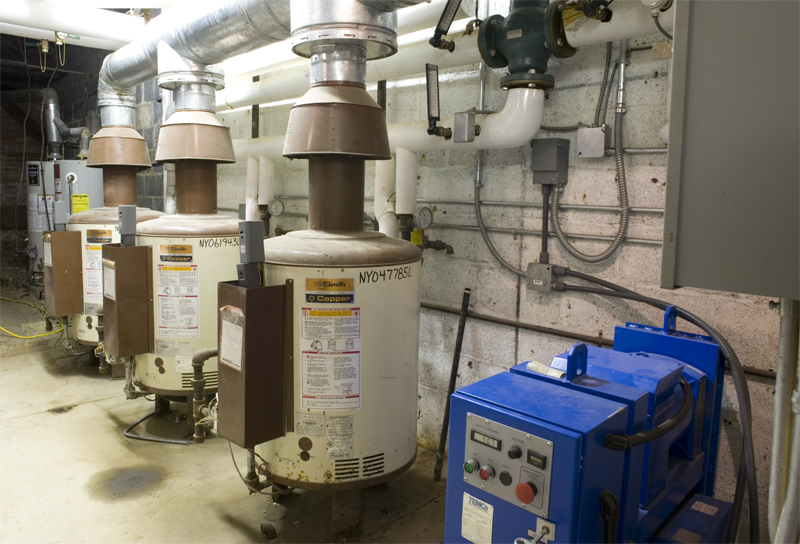
Figure 1. The propane-fired system that formerly heated the 10,000 square foot Cayuga Nature Center. The system is kept on standby as a backup
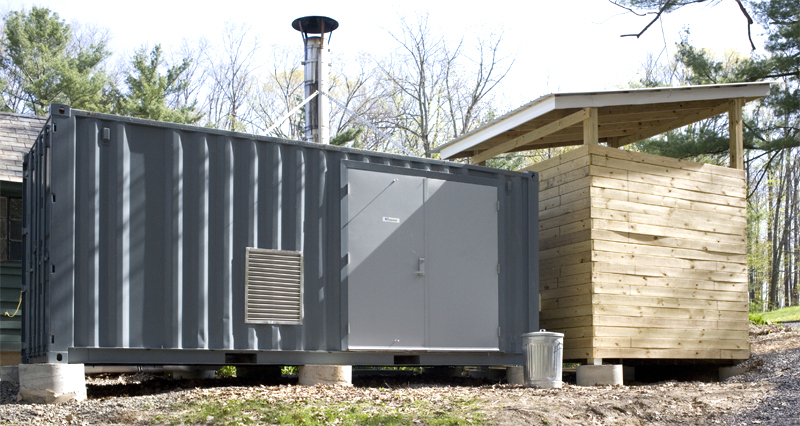
Figure 2. Exterior of new woodchip fired boiler. The wooden feed bin on the right holds about a week's worth of fuel at maximum boiler output. An auger automatically conveys fuel from the hopper to the boiler
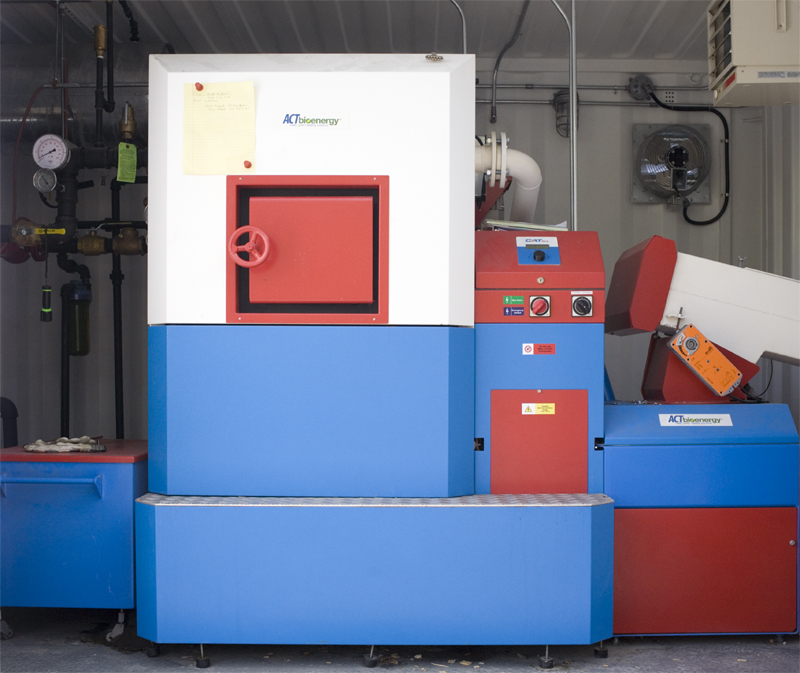
Figure 3. The boiler can produce 400,000 BTU per hour from wood chips
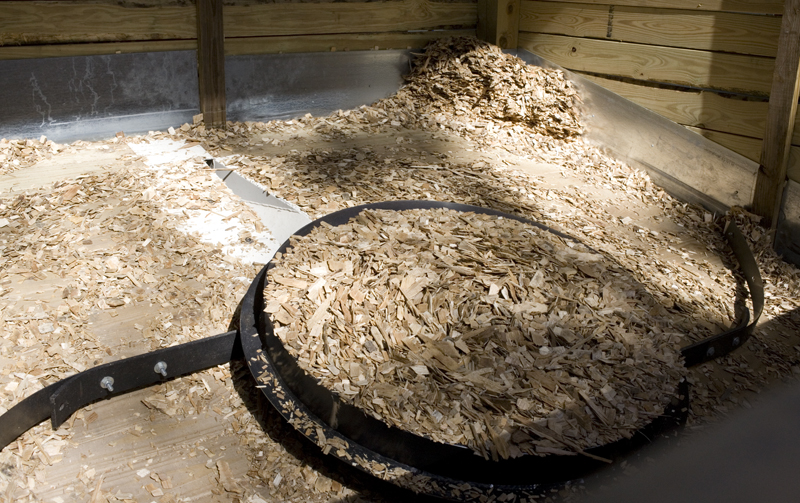
Figure 4. Interior of feed bin (almost empty) showing the sweeper that moves chips across the auger trough
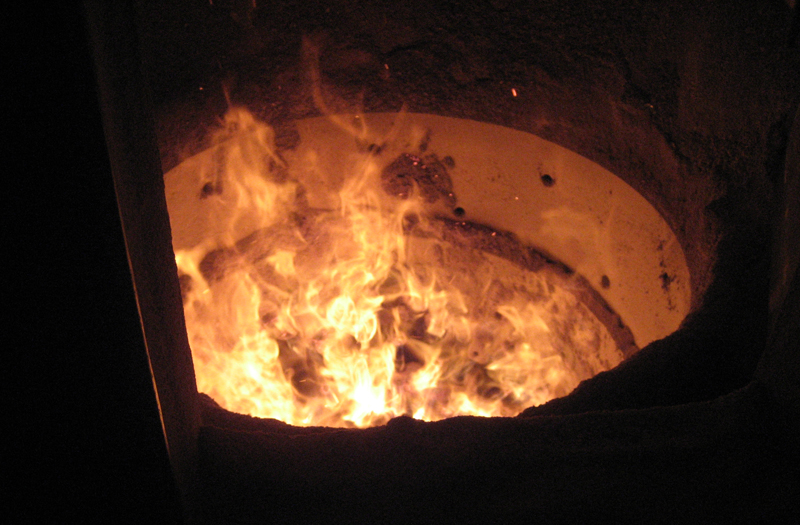
Figure 5. Chips are fed from below to the center of a grate at the bottom of the combustion chamber. Optimal combustion is achieved by controlling the air supplied through holes in the chip bed and holes on the sides of the combustion chamber. The ash produced by this process is less than one percent of the fuel burned
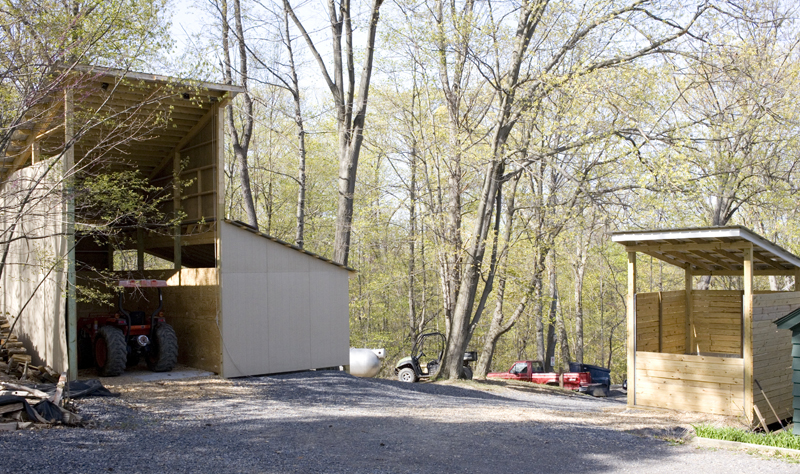
Figure 6. A 12 x 40 foot shed (on the left) stores chips to periodically replenish the feed bin (on the right). The shed was constructed with volunteer help from Cornell Engineers for a Sustainable World
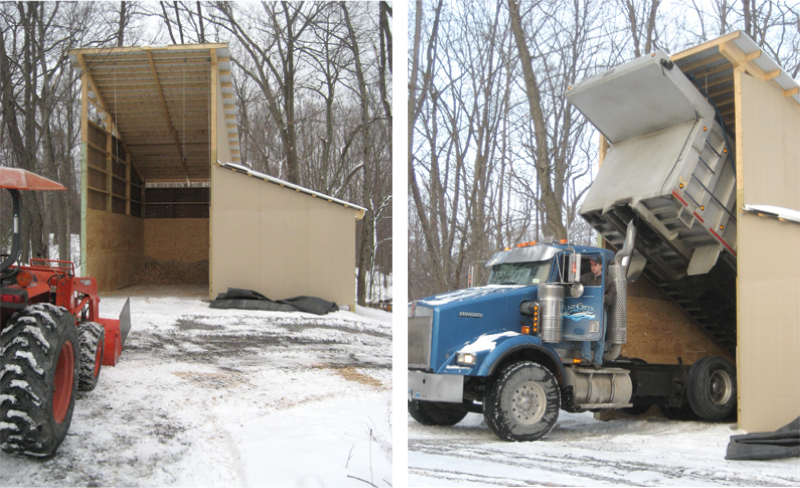
Figure 7. Left: The storage shed in winter and the front loader used to transfer chips to the feed bin; Right: Receiving a 10 ton (50 cubic yard) chip delivery from Mesa Reduction of Auburn, NY. The chips are made from the waste streams of regional lumber mills. In the future, some fuel will come from CNC and other nearby forests
This project would not have been possible without the determined and persistent effort of TC Local contributor and local biomass proponent Tony Nekut. NYSERDA was eager to have a demonstration project, and the Cayuga Nature Center was eager to solve the problem of high propane heat bills, but it took a local activist to bring the need and those with the funding together to make it work. While fuel costs have not yet been tabulated for the year, it is estimated that the new boiler will result in a 50 to 75 percent savings in fuel.
The CNC installation is part of a larger NYSERDA effort to support the evaluation and improvement of biomass-fired heating equipment. According to a recent press release,[4]
The program will clear a path for New York-grown fuels, create new manufacturing jobs, and improve environmental performance of biomass technologies….
ACT’s project at the Cayuga Nature Center in Ithaca, NY, will demonstrate a fully automated, 90 percent efficient wood-gasification boiler technology that is proven in Europe and adapted for the U.S. market. These systems have emissions that are significantly better than conventional wood boilers and comparable to typical oil or gas boilers. Mid-sized buildings (10–100,000 sq.ft.) represent 90 percent of the boiler market in the U.S., and are prime targets for these wood systems which can achieve rapid paybacks when replacing fossil-fuel boilers.
More information on this project is available at http://www.actbioenergy.com/brochure/Cayuga%20wood%20boiler%20photos.pdf
Town of Danby Highway Barns—Project to Retrofit ACT Bioenergy Boiler Using American Reinvestment and Recovery Act (ARRA) Funds
The Town of Danby has a high level of interest in biomass as a heat and energy source. Not only are Town elected officials and staff excited about the potential of making use of a local resource in moving away from fossil fuels, the residents of the Town are also very involved. Citizen involvement is primarily through the Danby Land Bank Cooperative,[5] which “provides an organization and an infrastructure that allows rural property owners to use their fields and forests for grass and wood pellet production.” In the neighboring township of Caroline, Cayuga Biomass Energy, a small group of entrepreneurs that includes TC Local contributor Tony Nekut, is attempting to start a biomass pellet manufacturing plant.
The projected cost to convert the Town’s 10,000 square foot office and truck bay complex to wood chip heat is about $267,000. While the projected fuel cost savings are estimated to be 50 percent or greater, a capital improvement of that scale is difficult for a small rural township to budget or buy bonds for; usually, help from a higher level of government is needed for improvements on this scale. In this case, the Town administration decided to pursue funding under the American Reinvestment and Recovery Act (ARRA)-the federal stimulus package.
As in the Cayuga Nature Center project, biomass proponents helped to bring the need and the source of funds together—in this case, Tony and I helped the Town of Danby make application for these funds by coordinating grant-writing and project specification tasks.[6] In March of 2010, NYSERDA awarded these federal funds to Danby. For its part in the project, the Town will contribute some highway worker hours to the excavation and concrete work needed to construct a covered fuel storage area. The boiler unit, which is almost identical to the one in use at Cayuga Nature Center, will be installed by a regional heating contractor, and the jobs producing biomass fuel will be hyper-local—ideally, in Danby or adjoining Caroline. In fact, the Town Highway crews plan to produce some of the wood chip fuel themselves in the process of keeping the roadways clear. This is a good use of a federal program aimed at maintaining and creating jobs in economically distressed counties like Tompkins.
RPM Ecosystem’s Combined Heat and Power Project/Biomass Demo Plantations
PJ Marshall, one of the principals of RPM Ecosystems[7], wanted to provide the heat and power to operate the firm’s Town of Dryden greenhouses and company headquarters while remaining carbon-neutral. And she wanted to do so using only the products RPM grows—native hardwood trees. Additionally, she sought to develop and demonstrate a biomass plantation system using native hardwood trees planted specifically for a combination fuel/lumber harvest, staged to produce first fuel wood and then lumber, over a number of years, while maximizing forest canopy and carbon sequestration throughout the process. RPM pursued this plan through local Congressman Michael Arcuri, looking to secure a federal appropriation to fund the project.
The company made good progress in developing the project and getting the appropriation drafted last year (2009) but then encountered difficulties when Congress passed a rule requiring that no appropriations go directly to private companies. RPM regrouped and engaged TCAD[8] as a fiscal sponsor for the projects. Heather Filiberto, Director of Economic Development Services at TCAD, describes the agency and its role in the project this way:
TCAD, the County’s lead economic development agency, is a non-profit organization whose mission is to build a thriving and sustainable economy that improves the quality of life in Tompkins County by fostering the growth of business and employment. In situations in which governmental funding must be received by a non-profit, TCAD has stepped in and sponsored applications on behalf of local entrepreneurs in the past. TCAD has agreed to sponsor this request for federal funding on behalf of RPM.
In order to succeed in getting an appropriation in the federal budget for a project, the applicants must obtain letters of support from a wide variety of local officials. The typical support letter is prepared by the applicant in overall substance, then transferred to letterhead and signed by the various elected officials with only slight modifications. The projects are briefly described along with the expected benefit to the community. The following excerpt, from Senator James Seward’s letter, demonstrates the approach.
I am writing to express my strong support for Tompkins County Area Development and RPM Ecosystems Ithaca LLC’s, innovative Dryden, New York, green building and renewable energy project titled Distributive Biomass Combined Heat and Power for CO2-Neutral Facility Operations….
…this project helps install and commission a 200KWe distributive biomass combined heat and power set for sustainable/renewable electricity and thermal energy production in support of RPM Ecosystems Ithaca LLC’s operations.…
TCAD, RPM Ecosystems, and Congressman Arcuri are all hopeful that the funding for this project will be included in this year’s federal budget. Still, the project must wait to commence until the political process runs its course.
Individual Homeowners Can Access Governmental Biomass Incentives
Some government-assisted financing options exist for individual homeowners interested in converting some or all of the heat or hot water produced in their homes to biomass fuels. Anyone who is in a position to benefit from a tax incentive can receive up to 30 percent of the cost of a pellet stove (not to exceed $1,500) in tax savings. A website is available to help with determining whether this program meets your needs,[9] or contact the Pellet Fuels Institute.[10] Local pellet stove merchants can also assist in understanding the program and which units qualify. Unfortunately, stoves and furnaces that burn cordwood are not eligible for these incentives.
NYSERDA also has some homeowner financing programs[11] for the installation of a pellet stove and for the energy efficiency retrofits that can be accomplished in conjunction with a transition to a heat source based on certain kinds of renewable fuel. In general, cordwood stoves and furnaces are ineligible for these programs. For homeowners with low or moderate income, low-interest financing programs, and even some grants, are available through Ithaca Neighborhood Housing Services.[12] Similar programs are available through Tompkins Community Action,[13] and some similar services may be available through Better Housing for Tompkins County[14] as a part of home rehabilitation. All of these housing agencies should be contacted to determine what programs might work best for your individual needs.
Most programs will require that you obtain a professional energy audit to determine which energy improvements may be most cost-effective for you. Even if you don’t use an incentive program, an energy audit can help you to tackle energy investments in the order that gives you the most benefit for the money invested. Conservation measures and efficiency upgrades are often more cost-effective than investing in a renewable fuel heat source. The housing agencies linked above can provide referrals for homeowners of all incomes to qualified energy audit providers and Building Performance Institute (BPI) certified contractors. In most cases, only BPI-certified contractors are eligible to perform work that will qualify for incentives. These energy auditors and BPI-certified contractors are also trained to make use of up-to-date methods and products for saving energy and using renewable fuels.
Funding and Finagling: Negotiating the Political Process to Transition to Biomass
Local, state, and federal governments are involved in energy policy and the implementation of energy projects in a number of different and evolving ways. Even a very savvy and motivated community such as Tompkins County may find it difficult to work the system well enough to get sufficient funding and financing for transitions to carbon-neutral and renewable fuel sources. Over time, government-funded energy efforts at conservation, which should always be the first step in a sustainable energy plan, have become institutionalized in a way that makes them more accessible to homeowners, businesses, and other community institutions. However, renewable energy conversions remain new enough that the path to government sponsorship is not always clear-in both the sense of “visible” and “free of obstructions.”
Some motivated activists claim that the slow grinding of the gears in the public sector is not worth the patience to accommodate. The fastest and best approach when projects are low-tech and inexpensive may be a community barn-raising kind of effort. However, commercial-scale projects in large buildings, or the highly efficient district heat and power systems that group many buildings in a densely developed area on one heating system, can’t easily be accomplished via small-scale community efforts. Both funding and implementation will typically require some level of governmental assist or substantial private investment of capital.
How do thinkers, planners, and activists work most effectively to bring about a transition away from fossil fuel dependence? Understanding the ways that the layers of government divvy up responsibility, and how they do and don’t collaborate, is an important place to start when developing a strategy.
Planning efforts go on at all levels of government—federal, state, regional, county, and municipal. Professional planners are often those who elected officials turn to for information and explanation of policy options, even though elected officials themselves enact policy. It is productive to educate both planners and elected officials about new policies on renewable energy enacted by other governments and to call their attention to demonstrations of new technology. By definition, planners are charged with taking the long view of our situation, and may be the first to show interest in emerging technology and trends. Eventually, however, elected officials must choose to implement new projects.
Those of us, planners or otherwise, who take a long view of our local adjustment to energy descent may consider funding for transitions away from dependence on fossil fuel to be one of the most vital things our governments can do to assure our future security. Implementing that transition can be accomplished by educating elected officials and the professional planners who advise them, and also by applying for and using the funds (grants and capital) and financing (low-interest loans and tax-exempt bonds) for the purpose when such are available. The process is likely to be difficult, even frustrating at times. To lead the way to a renewable-fuels future, we should focus on creating the will, knowledge, and capacity to make good use of every opportunity for implementing projects. The more we show each other how to heat with renewable fuels, the more examples of successful projects will be available to help others understand the benefits. Eventually, we will reach a tipping point at which the logic of using sustainable, renewable sources for our heat and power will make more sense than fighting one another for a rapidly-diminishing stock of polluting fossil fuels.
Notes
[1] http://tclocal.org/2009/10/burning_transitions.html
[2] http://tclocal.org/2010/01/heating_with_biomass_in_tompki.html
[3] http://www.actbioenergy.com/
[4] http://www.actbioenergy.com/news.html#
[5] http://www.danbylandbank.com/site/home.html
[6] Contact Tony Nekut or Krys Cail through the comments section linked to this article if your Tompkins County municipality or school district is interested in pursuing biomass heat funding; we are interested in sharing information.
[7] http://www.rpmecosystems.com/
[9] http://energytaxincentives.org/consumers/heating-cooling.php
[10] http://www.pelletheat.org/3/residential/taxCredit.html
[11] http://www.getenergysmart.org/SingleFamilyHomes/ExistingBuilding/HomeOwner/Financing.aspx
[12] http://www.ithacanhs.org/pdf/LendingServicesWeb020210.pdf
